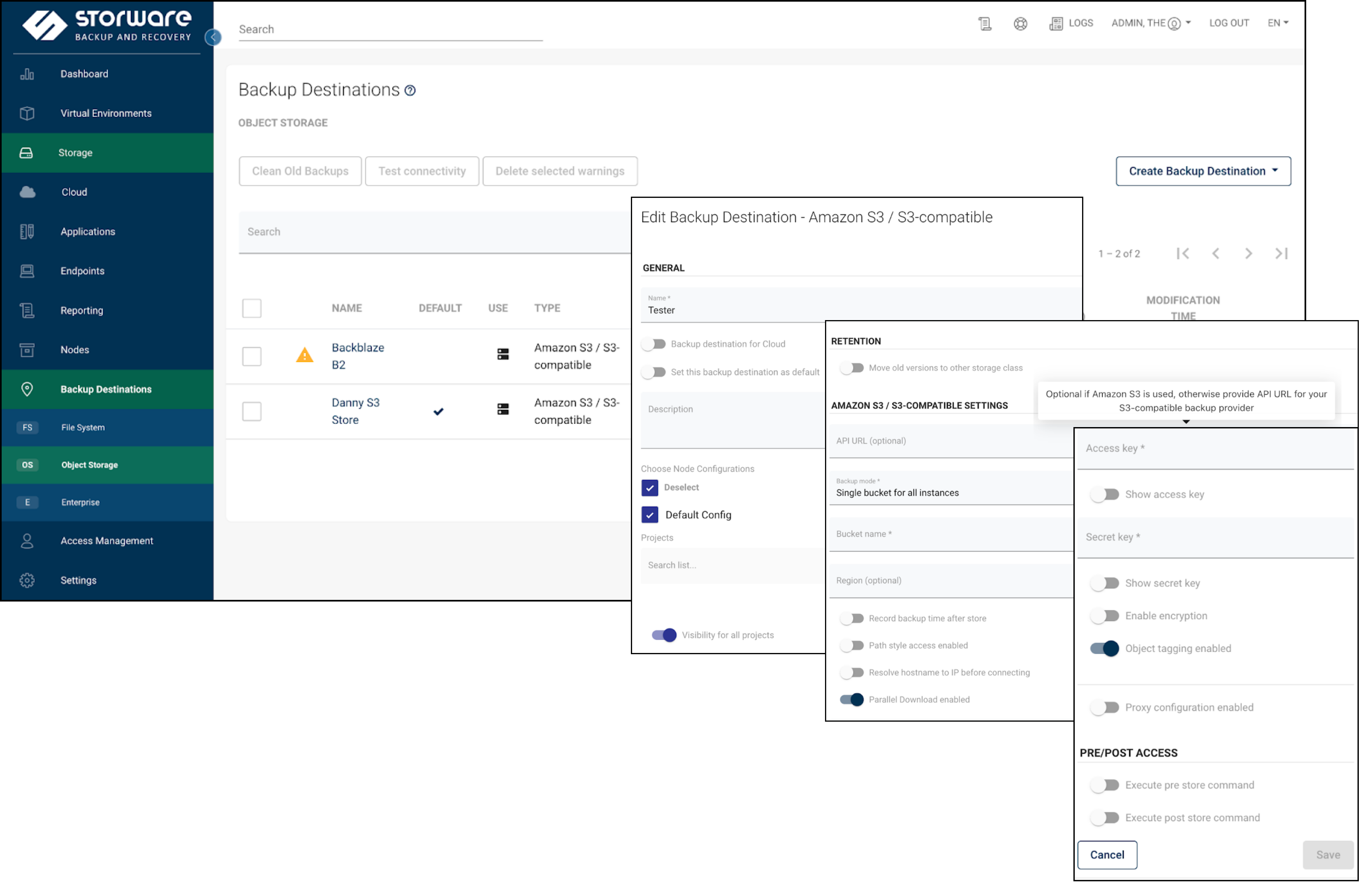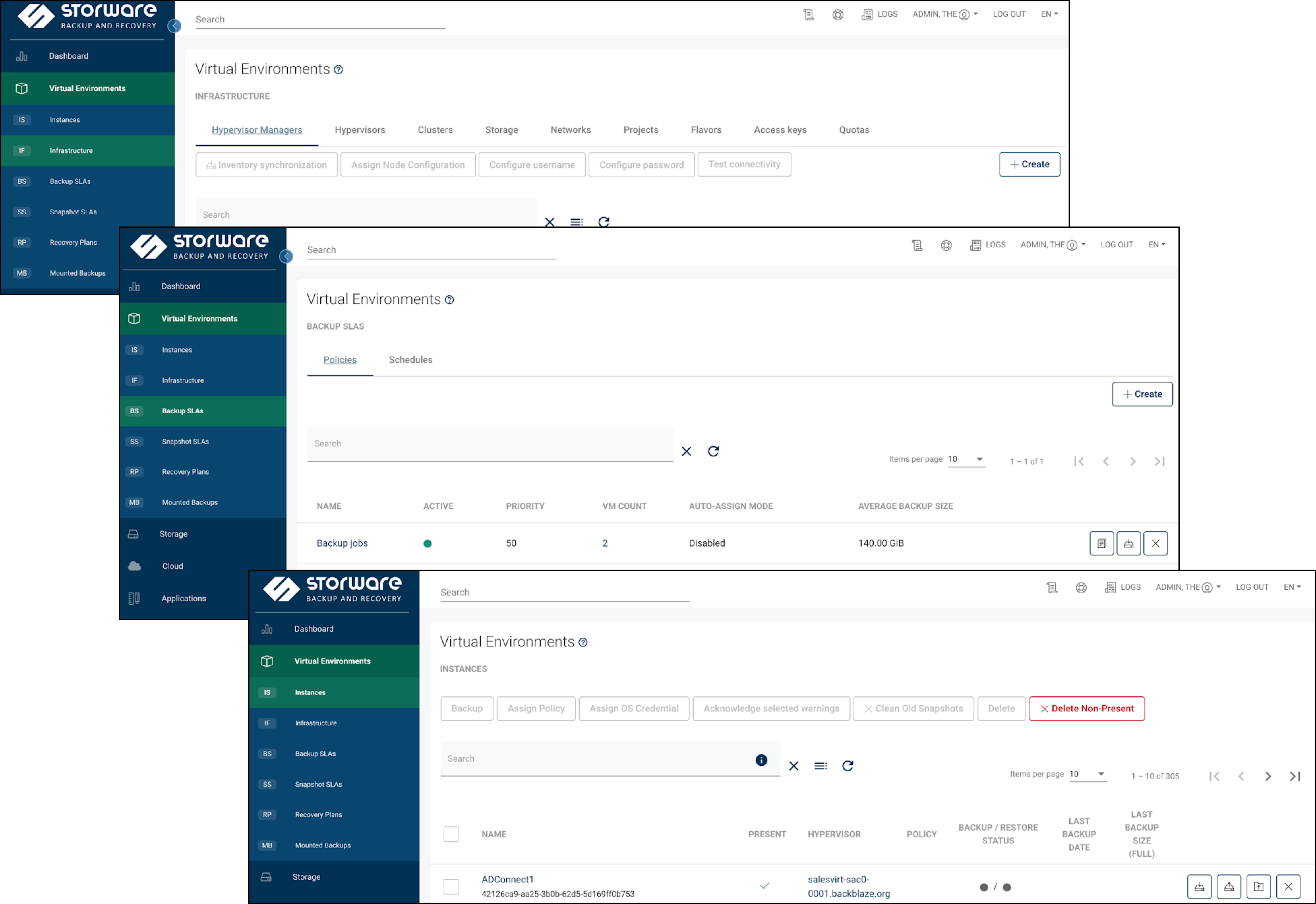- Print
- DarkLight
Storware Integration with Backblaze B2
- Print
- DarkLight
Storware provides a stable, agentless backup and snapshot-management solution for virtual machines, containers, storage providers, and applications that work on-premise and in the cloud. Storware supports multiple backup destinations for convenient data storage planning such as a local filesystem or a network file system (NFS)/common internet file system (CIFS) share, object storage (cloud providers), or enterprise backup providers.
Before you begin: You must set up and configure Storware Backup and Recovery. You must also set up a Linux Server Host.
Enable Backblaze B2
Before you begin: You must have a Backblaze B2 Cloud Storage account. If you already have a Backblaze account and the left navigation menu contains a B2 Cloud Storage section, your account is already enabled for Backblaze B2.
- Sign in to the Backblaze web console.
- In the user menu in the upper-right corner of the page, select My Settings.
- Under Enabled Products, select the checkbox to enable B2 Cloud Storage.
- Review the Terms and Conditions, and click OK to accept them.
Create a Bucket
- Sign in to the Backblaze web console.
- In the left navigation menu under B2 Cloud Storage, click Buckets.
- Click Create a Bucket.
- Enter a name for your bucket. Bucket names must be at least six characters and globally unique.
A message is displayed if your bucket name is already in use. - Select a privacy setting: Private or Public.NoteYou can change a bucket's privacy settings at any time.
Files that are in a private bucket require authentication to perform an action, for example, downloading.
Public buckets do not require authentication so you can easily access files. If this is your first time creating a public bucket, complete the following tasks to ensure that you have the correct permissions to create a public bucket:
1. Verify your email address.
2. Have a payment history on file, or use the credit card form to pay a small fee that is credited to your account balance. - If applicable, enable a Backblaze B2 server-side encryption key.
- Enable Object Lock to restrict a file from being modified or deleted for a specified period of time.
- Click Create a Bucket, and copy the value that is in the Endpoint field; you may need this value later.
- Click Lifecycle Settings to control how long to keep the files in your new bucket.
Create an Application Key
- Sign in to the Backblaze web console.
- In the left navigation menu under B2 Cloud Storage, click Application Keys.
- Click Add a New Application Key, and enter an app key name.
You cannot search an app key by this name; therefore, app key names are not required to be globally unique. Key names are limited to 100 characters and can contain letters, numbers, and "-", but not I18N characters, such as é, à, and ü. - Select All or select a specific bucket in the Allow Access to Bucket(s) menu.
- Optionally, select your access type (Read and Write, Read Only, or Write Only).
- Optionally, select Allow List All Bucket Names.
This option is required for the B2 Native API b2_list_buckets and the S3-Compatible API S3 List Buckets operations. - Optionally, enter a file name prefix to restrict application key access only to files with that prefix.
Depending on what you selected in step #4, this limits application key access to files with the specified prefix for all buckets or just the selected bucket. - Optionally, enter a positive integer to limit the time, in seconds, before the application key expires.
The value must be less than 1000 days (in seconds). - Click Create New Key, and note the resulting keyID and applicationKey values.
Add Backblaze B2 as a Storage Device

- Sign in to the Storware console.
- In the left navigation menu, select Backup Destination and select Object Storage.
- Select the Create Backup Destination menu, and select S3 compatible storage.
- In the General tab, enter a destination name and select a node configuration.
- In the Retention tab add an API URL. This field is optional if you use Amazon S3.
- Select Single bucket for all instances as the backup mode.
- Enter your bucket name.
- Select Parallel Download enabled.
- In the Keys tab, enter your keyID in the Access key field and enter your applicationKey in the Secret key field.
- Select Object tagging enabled, and click Save.
Configure Storware

- In the left navigation menu, select Virtual Environments and select Infrastructure.
- Enter the required information for a new Hypervisor or Hypervisor Manager.
- In the left navigation menu, select Virtual Environments and select Backup SLAs.
- Under Primary Backup Destination, select newly created Backblaze B2 storage devices.
- In the left navigation menu, select Virtual Environments and select Instances.
You should be able to see your available virtual machines (VMs). - Click the backup icon that is associated with that VM, and complete backups to the cloud.

